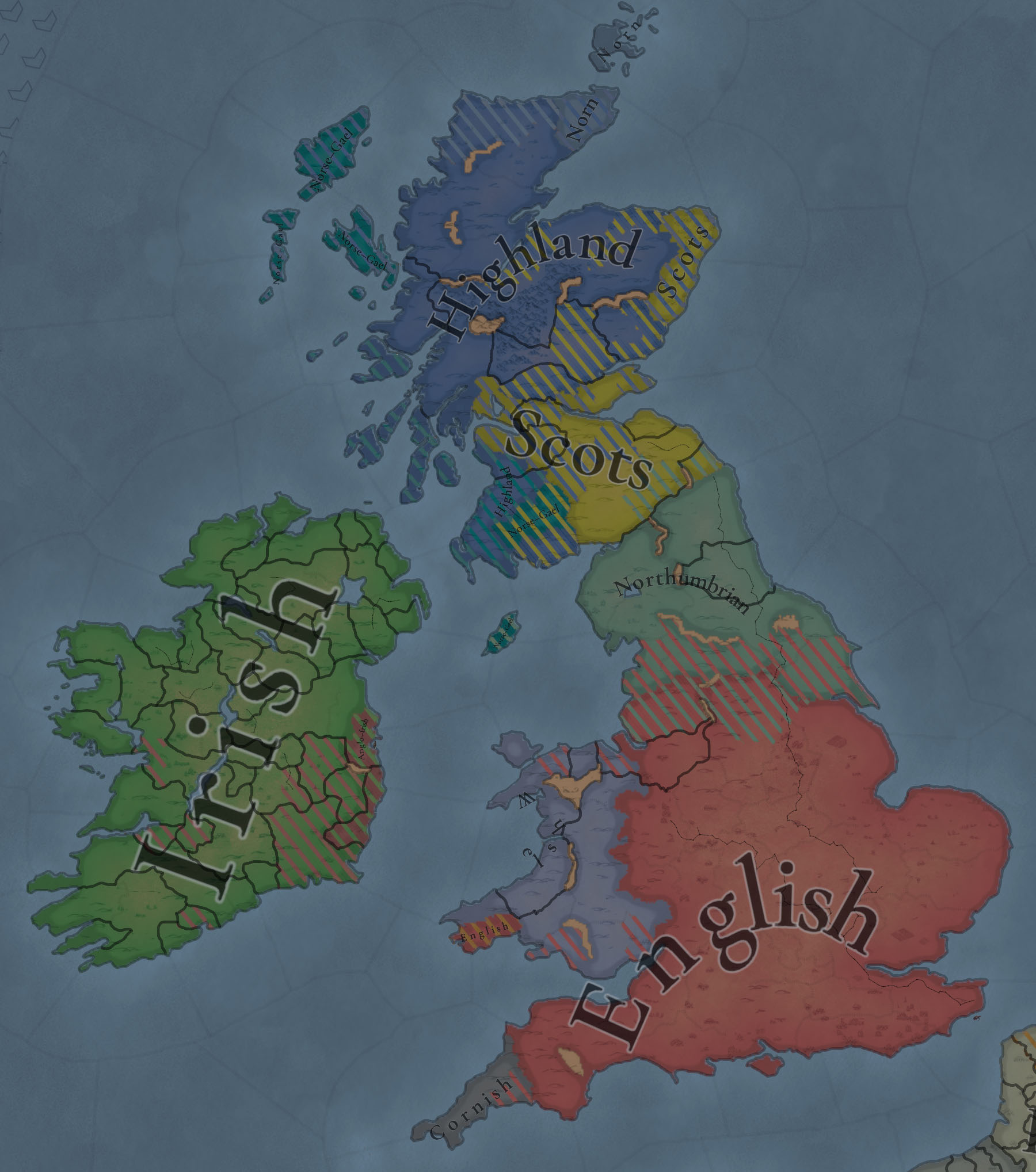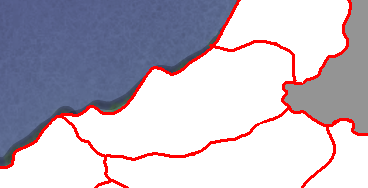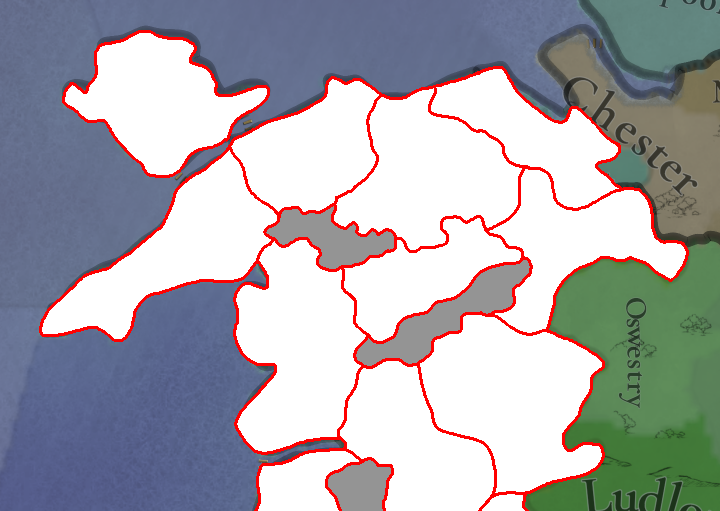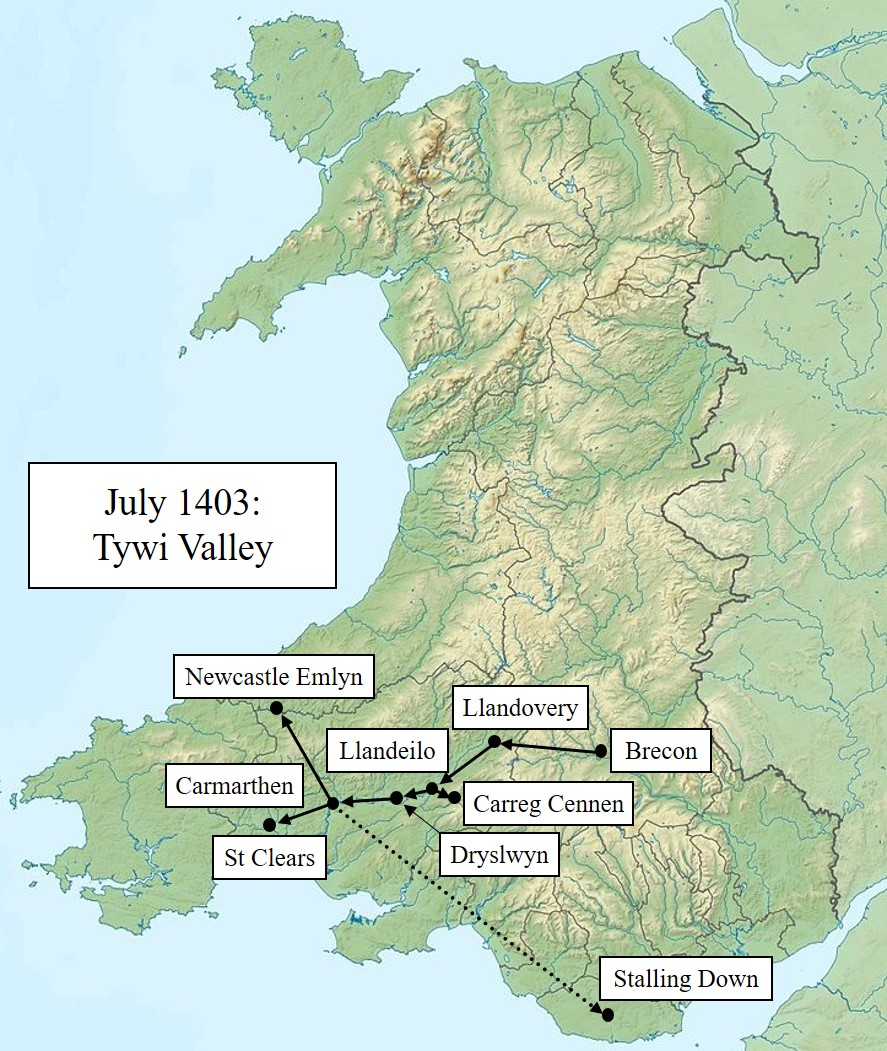Wales - Feedback and Suggestions Thread:
I'm sorry if this thread is a bit late or a bit long, but I just want to say that I am loving the changes so far, they are absolutely amazing and have added loads in the way of flavour. I 100% feel this may be the best representation of the UK and Ireland in a map game, so thank you to the devs.
I have a few more suggestions on this update like I had with the
previous one last year, mainly in terms of locations, the shape of the Principality and impassables which I'll post below. Any comments within is no critique at all, just a few views I believe may help as feedback for any developer reading!
On a side note, I also feel that the Marcher Lords should still 100% be added for Wales. It should be noted that the Bohemians have their marches in Silesia, France has their vassal swarm also. These islands have their equivalent by way of the Welsh and Scottish Marches and I feel these should be added as they were with both examples above. If the decision is made that the vassals should not be a map based entity such as the Principality, then I believe they should at least be Extraterritorial Countries such as the clans of the Japanese Shogunate, potentially with an International organisation for the
Council of Wales and the Marches at some point later in the game.
Number of Locations and Proposed Changes:
The entire Ulster region (including Cavan, Monaghan and Donegal) and Wales are approximately the same size both in real life and ingame. Whereas ulster contains some 27 locations, Wales only contains 19, the most sparsely populated of which are in the South, home to the historically significant grouping of populations, even prior to the transfer of populations to the Valleys for work purposes during the industrial revolution (though primarily focused around Carmarthen, Pembroke, Monmouth, Abergavenny, Grosmont, Caldicot, Neath, Newport, Caerleon, Swansea and Cardiff rather than the valleys).
Ulster vs Wales locations
It has been noted by Dave however that this has been upped to 22 so far with additions in Powys and Carmarthenshire. There should therefore be room to expand on south Wales further even if slightly, to maintain a similar balance of locations, as the divide between North and South Wales is somewhat stark too, with the North having 6 locations to the South’s 4. I would therefore suggest the separation of Swansea into Swansea and Neath, with Swansea representing more the Lordship of Gower than the borders of the modern county.
Newer location map as of this thread shown by Dave
I would suggest 4 locations to even the playing field somewhat, add more flavour to South Wales and enable more interesting movements, these locations would interact with impassables which would be delved into in another section of this post.
South Wales - Swansea/Neath Split and a Newport Location
Firstly, as South Wales is seemingly the least populated, I would suggest a split of Swansea into Swansea and Neath, following the borders of the Lordship of Gower and remnants of the location being assigned to Neath, representing the density of the South better.
Swansea Neath Split
Secondly, I would suggest once again the creation of a location for Newport which eats into the current locations of Caerphilly, Monmouth and Cardiff, representing in part not only the historic nature of the city but also the Stafford Lordship of Gwynllwg and the Mortimer Lordship of Caerleon as well as once again representing the density of South Wales better.
New Location of Newport/Caerleon
The newly proposed South Wales therefore would look somewhat like this, with the Brecon Beacons subject to further discussion in the impassables section.
Existing vs proposed South Wales
West Wales (1) - Location of Narberth/Laugharne/Llansteffan
Firstly in West Wales, I would propose once again a location representing either Narberth or Laugharne or Llansteffan as a means to better reflect the nature of the
Landsker line as well as a more accurate version of the borders of the
Principality of Wales, eating into the Pembroke location somewhat as well as Fishguard (to which Carmarthen should also gain land in). The addition of this location should ideally be alongside the better representation of the
three river confluence of the Towy estuary. Carmarthen had ample access to the ocean at the time, being a
flourishing port town with access to the ocean via the Towy river, guarded upstream by Llansteffan Castle
1) Carmarthen Port located to the bottom of the above image, 2) The View of the Towy estuary from Llansteffan Castle
Existing as shown by Dave via this thread vs Proposed
(Note that the new location of Narberth/Laugharne/Llansteffan eats into Fishguard slightly in the top right, whilst the location of Carmarthen likewise eats into the Fishguard location, representing the Newcastle Emlyn region of the Teifi Valley controlled by Carmarthenshire for quite some time and redistributing location size more evenly)
In adding this location, the boundary of the invading Flemish/English settlers becomes clearer, as the Landsker line formed as a clear and stark contrast between the communities located either side for many centuries. Such an inclusion would also enable a more dynamic movement in the region, as with a clearer Tywi estuary, the importance of Carmarthen is exemplified, any access west or east would first require travelling through Carmarthen, elongating walking distance slightly between Pembroke and Carmarthen as well as forming more coherent traditional boundaries of both Pembrokeshire and Carmarthenshire respectively.
I also note that Carmarthen is no longer shown as being part of the principality of Wales via the latest update, the redesign of the borders should enable a more accurate depiction of the principality, with the Carmarthen location being a critical location to the southern regions.
West Wales (2) - Correction of the Ceredigion/Carmarthenshire border
This one may be somewhat small, but necessary to accurately depict the region. The shape of the Carmarthen-Cardigan boundary is rather off, with Carmarthen eating into much of the Ceredigion portion of the upper Teifi valley, likewise, Ceredigion has eaten much of the Carmarthenshire side of the middle Teifi valley, forming an elongated Ceredigion border, merging into an oddly shaped impassable state (to be raised later)
Existing vs Proposed
Proposed + terrain map overlay.
North Wales - Penllyn Location and correction to Flintshire boundary
Now that Dave has confirmed that Harlech has expanded to represent the Penllyn area of the Principality better, I believe it necessary to split the historic area/cantref of Penllyn from Harlech to highlight the importance of the area as a crossroads in the region. The inclusion of this location makes movement in North Wales more accurate, depicting the Glacial Valley to which the town of Bala is central. Bounded to the North-west by the
Migneint Uplands and to the south by the
Berwyn Mountain range.
This region was an important military route travelled by Glyndwr on his way South during the lead up to the Battle of Hyddgen, as he was perused by the
Justiciar of North Wales. It is also said that the eastern portion of this location is where Glyndwr was attacked by a force led by his Cousin
Hywel Sele at Nannau.
The existing impassable through the region is somewhat puzzling, as the locations representing Corwen and Llangollen cannot interact with Denbigh (which contains Ruthin). This cuts off the naturally low laying terrain linking the upper Dee Valley and Clywedog valley. The cause of the War of Independence was border disputes in the area between Glyndŵr and the Lord of Ruthin who illegally seized land, Glyndŵr then marched through what would be impassables ingame up from Corwen to Ruthin on his march of 1400.
Existing vs Proposed.
Glyndŵr's 1400 campaign through the area.
The Flintshire boundary at current is anachronistic, representing the
modern boundary. The
traditional boundary of Flintshire extended further north-west than the current boundary which was formed only in 1996. The current location is also too large to the east, seemingly containing the city of Chester, I believe the cause of this is the lack of representation for the
canalisation of the river Dee in the 1700s, which eventually caused a reclamation of land which currently forms the portion of Wales North of the River, something which
I had mentioned previously.
Traditional boundary vs modern 1996 boundary of Flintshire.
The proposal therefore is for an increase in size for Flint, with Denbigh consuming much of the reduntant impassable. This has the unintended benefit of accurately reflecting the historic county of Denbighshire to a certain extent also.
Existing vs Proposed
Impassables:
South Wales (Afan Forest and the Beacons)
I understand that the impassable currently formed within South Wales is a means to highlight the undulating nature of the Afan forest and portions of the Brecon Beacon, however the extent is a little too much in my opinion and cuts across major logistic routes of the period.
Subjected to this impassable range are the locations listed as Kidwelly and Brecknock. Whilst it’s true that the area is heavily undulated, the stretch between Llandovery and Brecon remained one of the most crucial military passages for both the Roman period as well as during the conquest of Wales,
especially around Trecastle, remaining the frontier between much of the marcher lords and the native princes and
later forming a Turnpike Road.
Llandovery-Brecon path
During the last war of Independence (Glyndŵrs revolt) it was noted that the second royal expedition into Glyndŵr held Wales in 1402 utilised this route to attack Carmarthenshire under the lords Stafford, Warwick and Arundel), both ways by the expedition of 1403 (there and back), Glyndŵr's 1403 offensive, as well as by the army of Rhys Ap Thomas in the lead up to the Battle of Bosworth.
Military campaigns utilising the path, namely the royal expeditions of 1402 and 1403, Glyndŵrs use of the path and the march of the Tudor forces to the Battle of Bosworth
Furthermore, a Roman Road ran through the Vale of Neath to the Roman fort of Nidum (Modern day Neath) towards Brecon which was also utilised throughout the Middle Ages and the length of the game’s timeframe, forming part of what is known as Sarn Helen.
Both areas can be seen in the following map highlighting Roman Roads in Wales:
I would suggest rather than this large area, an impassable range reflecting the black mountains instead, which though smaller, would represent the impassability of this part of the Brecon Beacons. I would suggest that the entirety of the Beacons be made impossible, however the route from Cardiff, through Caerphilly to Brecon was well established and the representation of eastern portions of the Beacons would prove a bit pointless as without the inclusion of further locations in the south, all existing locations would connect regardless of the impassable.....though of course one could be there for aesthetic purposes.
Alternatively, if accepting the slight redesigning south Wales to include the Swansea/Neath split and the addition of Newport, it would be feasible to add an eastern portion of the beacons that would have a meaningful impact ingame, preventing access from Newport to Brecon, but still enabling access from Caerphilly to represent the old Roman Road. This would broadly correspond with the entire Brecon Beacons with a connection between Caerphilly and Brecon via what is now the A470 at Storey Arms and Nant-ddu.
Current Impassable set up vs proposed with 2 Brecon beacon Impassable and 2 new locations as noted prior:
Mid Wales - Desert of Wales
Only a small one,
the Desert of Wales at current is shown as being quite thin and hooked like, not really representing the accurate shape of the highland area visible by terrain and satellite imagery. The proposed in this instance works in conjunction with the redesign of the Ceredigion/Carmarthenshire border to form a more realistic looking Desert of Wales.
North Wales - Berwyn Mountains and the Migneint Uplands
I note that the Berwyn mountain range is now in-game in Dave's latest posts, but also note that some impassable to the North has been added, this seemingly corresponds to a slight degree to the undulating terrain surrounding the Tryweryn reservoir, however, extends almost 16.5 miles beyond. The area seemingly cuts across the Upper Dee and Upper Conwy valley areas, low lying terrain which has been settled for centuries.
Should devs wish to keep this impassable to an extent, I would suggest that this be broadly represented by the zoning of the
Migneint-Arenig-Dduallt Special Area of Conservation as well as the
Moelwynion mountain range north of Blaenau Ffestiniog. Depicted below is the Migneint SAC, as well as the Berwyn and South Clwyd Mountains SAC, mapping of the Berwyn Impassable could also follow this Special Area of Conservation should Devs find it handy and wish to replicate.
Migneint-Arenig-Dduallt and Berwyn and South Clwyd Mountains Special Areas of Conservation
Conclusion:
In adding the 4 suggested locations, the location density in Wales would match that of other regions depicted via this
Tinto Talks EUV Dev Diary, notably Ulster and other regions of Ireland. South Wales at current is greatly under-populated in terms of locations and the inclusion of the proposed allows for a more accurate depiction of impassable's within the region, notably the Brecon Beacons.
In altering Pembrokeshire, Ceredigion and Carmarthenshire as proposed, the area would be much more capable of representing the Principality of Wales in an accurate way, whilst the pivotal importance of Carmarthen as a logistical and military hub for the region would be amplified.
Alterations to North Wales via the splitting of Harlech into Harlech/Penllyn (or Bala, makers pick I guess) as bounded by the more accurate impassable regions would enable a more historically accurate depiction of unit movements through North Wales in conjunction with the slight redesign of the Denbigh and Flint locations to represent the Historic areas of Flintshire and the northern portion of Denbighshire more accurately.
Lastly, find below the existing as depicted via this dev diary and updates found within compared to proposed alterations in this thread as well as what the Principality would look like were these updates included (Wastelands controlled slightly coloured also):



















































